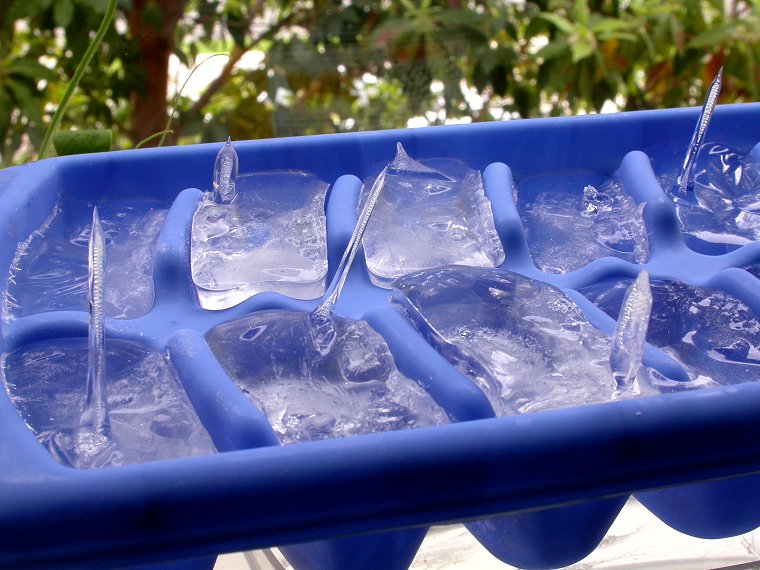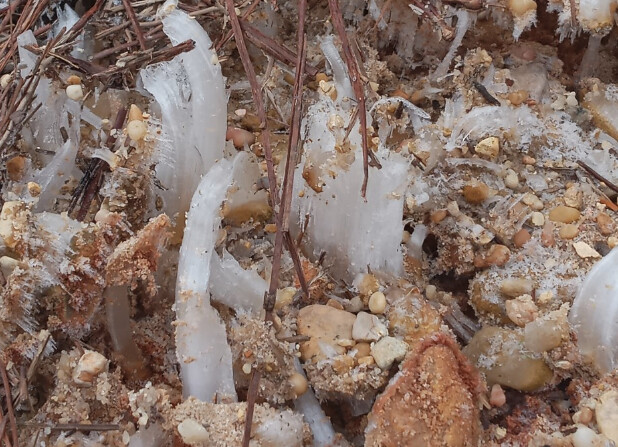During the cold weather, I received a handful of emails and messages with some great pictures of a unique weather phenomenon: Needle Ice.

Often times, when the air is below freezing, the ground is wet and above freezing, and the wind is calm… these cool little ice formations can develop near the ground.
Or, maybe, in your freezer!

Okay, so this isn’t exactly the same thing, but it is based on a similar principle.
The “Ice Spikes” you’ve seen form in your freezer, or a bird bath, or any other small body of water typically form when the surface of water freezes and a little hole is left over allowing liquid water to poke out of the hole as the rest of the water freezes.
You can almost think of it like those snake fireworks on the Fourth of July that keep growing-and-growing. Only, the ice spike is frozen, and those fireworks are, well, on fire.
Back to the ice… As the water under the frozen surface continues to freeze, it pushes out the excess water which also freezes. And it does this over-and-over-and-over again, until you get to a point where you have a little spike.
If you want more information about Ice Spikes, I would highly recommend checking out this page.
Wait, so what is Needle Ice then, Nick?
Needle Ice forms close to the ground when water it frozen and pulled out of the ground from something called capillary action and ice segregation. And it looks like this:

The ice forms into little ice stalagmites form from ice segregation and capillary action due to water being “sticky” to everything. Including itself!
From the USGS:
Capillary action is important for moving water (and all of the things that are dissolved in it) around. It is defined as the movement of water within the spaces of a porous material due to the forces of adhesion, cohesion, and surface tension.
Capillary action occurs because water is sticky, thanks to the forces of cohesion (water molecules like to stay close together) and adhesion (water molecules are attracted and stick to other substances).
Adhesion of water to the walls of a vessel will cause an upward force on the liquid at the edges and result in a meniscus which turns upward. The surface tension acts to hold the surface intact. Capillary action occurs when the adhesion to the walls is stronger than the cohesive forces between the liquid molecules.
The height to which capillary action will take water in a uniform circular tube (picture to right) is limited by surface tension and, of course, gravity.
USGS.GOV
In fact, a good experiment you can run at home to showcase this effect is to take a paper towel and dip half of it into a glass of water for a few seconds and then pull it out. Holding it out so that it isn’t crinkled up or folded over in any spot, you can watch the water climb up the paper towel.
A very similar phenomenon is happening to make Needle Ice!
If the ground is wet, the air is below freezing, and not fully saturated… water will exit the from below the surface of the ground. If the air is below freezing, the water will freeze as it exits the ground. And it will do this over-and-over-and-over-and-over again. Until a little needles form.

This happens due to ice segregation.
According to the National Snow and Ice Data Center, ice segregation is “the formation of discrete layers or lenses of segregated ice in freezing mineral or organic soils, as a result of the migration (and subsequent freezing) of pore water.“
And often times, the latest heat release from forming the ice helps to keep the ground above freezing, despite the air temperature being below freezing! And that, in turns keeps the water in the soil liquid. And that liquid water is pumped up past the surface, and freezes!
Can we do anything to make this happen when its cold?
That is a GREAT question. The answer is…. Maybe. But that is what experiments are all about! Trying!
The best way to try and make your own at home is to pick a night when the temperature will be below freezing for more than 10 hours. Preferably a low temperature around 25 degrees – or colder. Go out to the yard somewhere with exposed dirt and maybe some rocks and pebbles and slowly pour about a gallon of water onto the ground. slow enough that it doesn’t runoff and puddle up somewhere else, you want it to soak in really well.
Then, as it cools down at night, ice may begin to form. If the wind is calm, needle ice should start to form after about six hours. Depending on how long it is below freezing you may be able to build tiny little needles or longer ones.
These needles can be thick or thin and can even form on little rocks and clumps of dirt above the surface. The limiting factor is how porous the surface on which the ice is forming. The more porous, the more water it can deposit on the needle ice that is forming.
Cool stuff!

